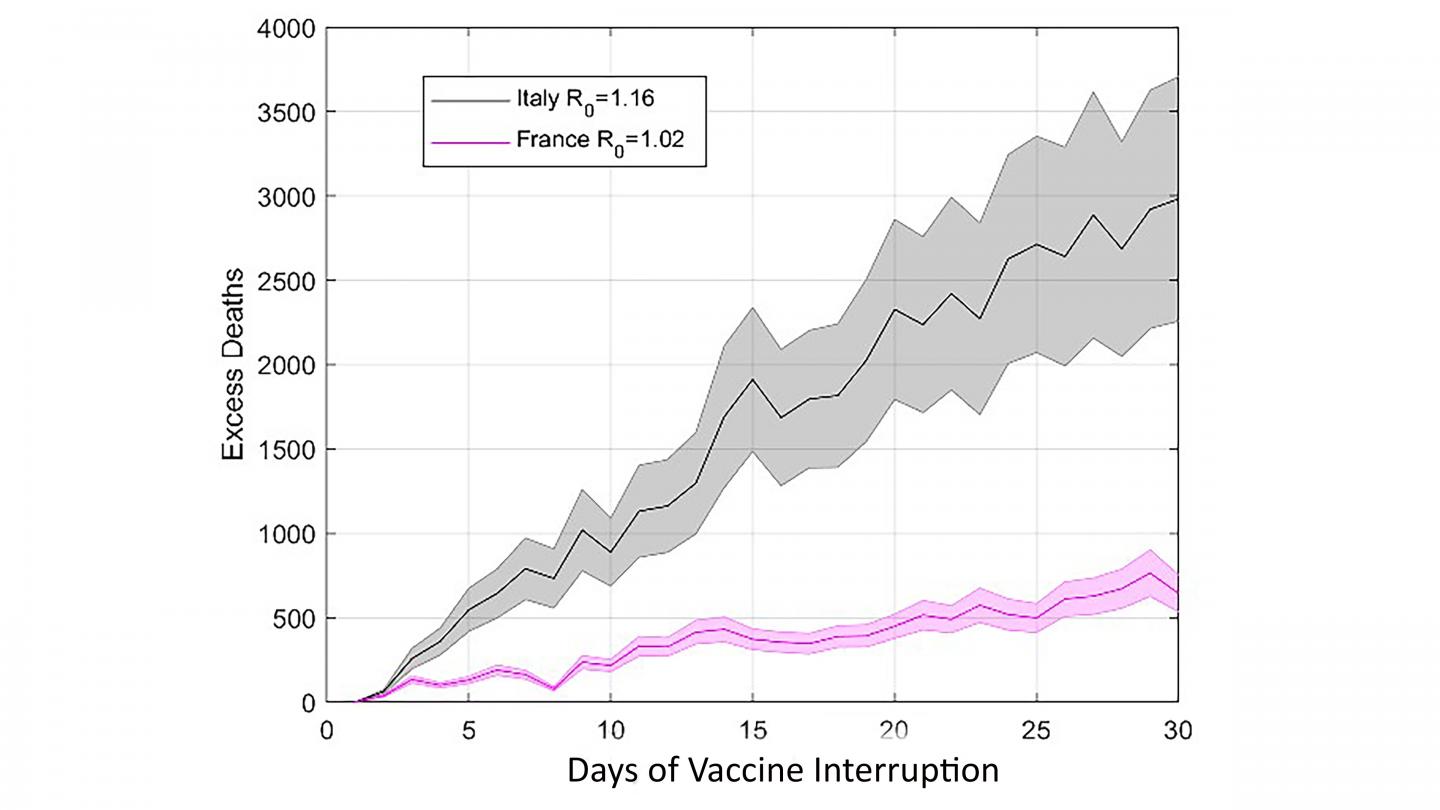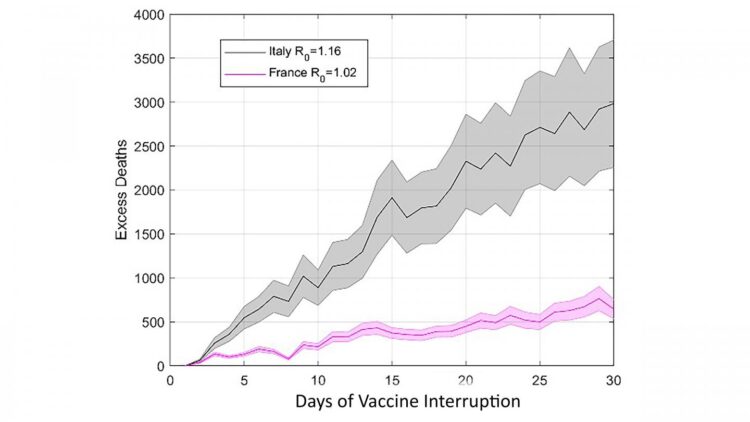Pausing AstraZeneca vaccinations because of suspected links to deadly blood clots could allow COVID-19 to continue to spread, cause more deaths.

Credit: Davide Faranda, Tommaso Alberti, Maxence Arutkin, Valerio Lembo, and Valerio Lucarini
WASHINGTON, April 27, 2021 — The AstraZeneca COVID-19 vaccine is suspected of being linked to a small number of deep vein thrombosis (DVT) cases, which recently emerged within Europe as millions of people received vaccinations. This led several countries to suspend AstraZeneca injections and investigate the causal links to DVT.
Researchers within Europe teamed up to explore a hypothesis that pausing AstraZeneca vaccinations, even for a short duration, could cause additional deaths from the faster spread of COVID-19 within a population of susceptible individuals.
In Chaos, from AIP Publishing, researchers report using an epidemiological susceptible-exposed-infected-recovered (SEIR) model and statistical analysis of publicly available data to estimate excess deaths resulting from suspending AstraZeneca vaccinations and those potentially linked to DVT-adverse events in France and Italy.
They concluded the benefits of deploying the AstraZeneca vaccine greatly outweigh its associated risks, and relative benefits are wider in situations where the reproduction number is larger.
The SEIR model was discussed in a paper, published by Chaos, titled “Modeling the second wave of COVID-19 infections in France and Italy via a stochastic SEIR model.” It was able to predict the magnitude and timing of the second wave of the disease in France and Italy.
“Despite its simplicity, the model is able to propagate uncertainties via adding interactivity as a source of randomness within the data,” said Davide Faranda, from Laboratoire des Sciences du Climat et de l’Environnement and the London Mathematical Laboratory. “It mimics our ignorance of the exact parameters of the model due to testing capacities and evolving political and medical protocols.”
Risk-benefit analysis is performed by using a methodology inspired by the Fermi estimates. The group compares the excess deaths due to temporal restriction of the AstraZeneca vaccine’s deployment and excess deaths due to its possible side effects. Given the many uncertainties of possible side effects of the vaccine, they resorted to making worst-case scenario calculations to provide a robust upper bound to the related excess deaths.
“Our work shows suspending AstraZeneca vaccinations in France and Italy for three days without replacing it with another vaccine led to about 260 and 130 additional deaths, respectively,” said Faranda. “The difference between the two countries’ number of deaths is due to their different epidemiological situations and, in particular, to the higher basic reproduction number R0 measured in Italy with respect to France on March 15, 2021.”
The group analyzed the case of resuming vaccinations at a doubled rate for the same number of days as the vaccination interruption.
“Excess deaths are still on the same order of magnitude as those observed by resuming vaccinations at the same rate as before the interruption but scaled down by a factor of two,” said Faranda. “This is an evident outcome of nonlinear effects of epidemiological dynamics. Those who have not been vaccinated can contaminate other individuals before vaccination resumes.”
Even if several countries have resumed or are about to resume AstraZeneca vaccinations, the researchers show the effect of the interruption is hard to counterbalance and will require doubling down on deployment of vaccines. For large countries where AstraZeneca vaccinations have resumed, confidence in vaccines has been reduced by a nonnegligible percentage.
“The analysis presented here was performed with a parsimonious but well posed and tested model, and we hope our results will be the starting point for more detailed, more advanced, and more mature investigations with sophisticated models and data collection exercises,” said Faranda.
A first proof of the validity of their estimates is the report of seven DVT deaths per 18 million vaccinations within the U.K., a value that is in line with the group’s work based on data available a few weeks ago and assuming a standard fatality rate of DVT from AstraZeneca vaccinations.
###
The article “Interrupting vaccination policies can greatly spread SARS-CoV-2 and enhance mortality from COVID-19 disease: The AstraZeneca case for France and Italy” is authored by Davide Faranda, Tommaso Alberti, Maxence Arutkin, Valerio Lembo, and Valerio Lucarini. It will appear in Chaos on April 27, 2021 (DOI: 10.1063/5.0050887). After that date, it can be accessed at https:/
ABOUT THE JOURNAL
Chaos is devoted to increasing the understanding of nonlinear phenomena in all areas of science and engineering and describing their manifestations in a manner comprehensible to researchers from a broad spectrum of disciplines. See https:/
Media Contact
Larry Frum
[email protected]
Related Journal Article
http://dx.





